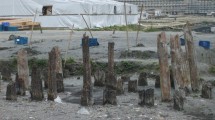Abstract
Fossil woods from the lignite quarry of S. Barbara (Arno basin, Italy) were investigated for their terpene content. Comparison was made with the samples of the same mine, recently identified asTaxodioxylon gypsaceum, and with theTaxodioxylon gypsaceum of the fossil forest of Dunarobba (Central Italy). The new sample exhibited a terpene composition similar to that of the previous ones except foriso-phyllocladene, the presence of which could be ascribed to the different ageing environment. Complete analyses of terpenes ofCryptomeria japonica, a species belonging to theTaxodiaceae, have shown that its terpene composition represents with good approximation the original one ofTaxodioxylon gypsaceum.
Zusammenfassung
Fossiles Holz aus einem Braunkohleabbau in Italien (S. Barbara, Arno-Becken) wurde im Hinblick auf seinen Terpengehalt untersucht. Die Ergebnisse wurden verglichen mit Untersuchungen an anderen Proben aus derselben Fundstelle, die kürzlich alsTaxodioxylon gypsaceum identifiziert worden waren. Weitere Vergleiche waren möglich mit Funden vonTaxodioxylon gypsaceum aus einem fossilen Wald bei Dunarobba (Italien). Die neuen Funde wiesen eine ähnliche Terpenzusammensetzung auf wie die früheren Fundstücke mit Ausnahme eines zusätzlichen Gehaltes an Isophyllocladen, dessen Vorkommen auf unterschiedliche Umgebungsbedingungen beim Alterungsprozess zurückzuführen sind. Eine vollständige Analyse der Terpene vonCryptomeria japonica, die zu den Taxodiaceen gehört, zeigte, daß deren Terpene mit guter Näherung die Originalzusammensetzung der fossilen Species repräsentieren.
Similar content being viewed by others
References
Biondi E (1996) Private communication
Menchi G, Matteoli U, Staccioli G, Bambagiotti Alberti M (1995) Catalytic hydrogenation in the identification of costituents of an Italian lignite. Fuel. 74: 426–430
Morita S, Yatagai M, Fujita S (1995) Distribution of the Extracts and Sesquiterpenes in the Trunks of Yakusugi (Cryptomeria japonica). Mokuzai Gakkaishi, 41: 938–944
Philp RP (1985) Fossil Fuel Biomarkers. Application, and Spectra. Elsevier Amsterdam, p. 143–144
Staccioli G, Mellerio G, Bambagiotti Alberti M (1993) Investigation on terpene-related hydrocarbons from a pliocenic fossil wood. Holzforschung, 47: 339–342
Staccioli G, Seraglia R, Traldi P, Menchi G, Matteoli U (1994) Nature of terpenoids of aTaxodioxylon gypsaceum from the fossil forest of Dunarobba (Italy). Holz Roh-Werkstoff. 52: 39–41
Wise LE, Jahn EC (1952) Wood Chemistry, Reinhold New York, p. 559
Zavarin E, Cool L (1991) Extraneous Materials from Wood: Wood structure and composition. M. Lewin, I. S. Goldstein, Eds., M. Dekker, New York, p. 345–348
Author information
Authors and Affiliations
Rights and permissions
About this article
Cite this article
Staccioli, G., Menchi, G. & Matteoli, U. Degraded terpenes ofTaxodioxylon gypsaceum and its likely original terpene composition. Holz als Roh- und Werkstoff 55, 337–338 (1997). https://doi.org/10.1007/s001070050242
Issue Date:
DOI: https://doi.org/10.1007/s001070050242




